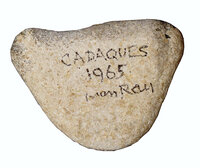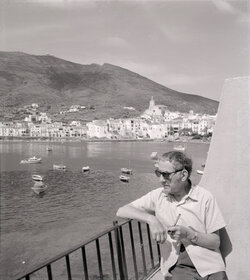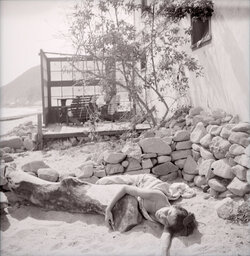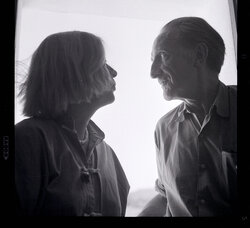

(Philadelphia, 1890 - Paris, 1978)
Sans Titre (Cache Sexe), 1965
Object found and painted
Black paint on agglomerated stone (ceramic) worn by the sea
Signed, dated and located on the back Man Ray / 1965 / CADAQUES
8 x 10 x 1,5 cm
Unique work executed in Cadaqués in 1965

Provenance :
- Man Ray, his studio and home located at 2 bis, rue Férou, Paris 6e
- Collection Peter Adam (1929-2019), Paris, offered by Man Ray circa 1972
- Private collection, France
Exhibition :
Le Soleil des Morts, project organized by Margaux Knight & Eladio Aguilera Hermoso,
September 20 to October 18, 2024, 11 Cité Falguière, Paris 15e
Literature:
- Mémoires à contre-vent by Peter Adam, éditions La Différence, Paris, 2010, mentioned and described on page 294
- Recorded in the Man Ray Expertise Committee archives for the Catalogue of Objects and Sculptures of Man Ray, currently in preparation.
In the summer of 1965, Man Ray and his wife Juliet spent a vacation in Spain at Cadaqués. The couple met their friends Marcel Duchamp and his wife Alexina, as well as Salvador Dali and his wife Gala. Dali settled in 1930 in a small fishermen's house in Portlligat, near Cadaqués, which he modified and enlarged over the years; he worked and lived there until Gala's death in 1982. Duchamp visited Cadaqués for the first time in 1933 and made it his summer residence from 1958 until his death in 1968. Man Ray liked to stay in Cadaques where he played chess with Duchamp.

MAN RAY, Selfportrait, Cadaquès, 1965 - Photo, Coll. MNAM, Paris

MAN RAY, Juliet Man Ray, Cadaquès, 1965 - Photo, Coll. MNAM, Paris

MAN RAY, Alexina and Marcel Duchamps, Cadaquès, 1965 - Photo, Coll. MNAM, Paris
On the beach, in the summer of 1965, Man Ray discovered a shard of ceramic with a patina from the sea, like a pebble, and from which he created our object, which he diverted a little using the Ready-Made process. This small "talisman" object declines themes dear to Man Ray, eroticism and humor.
Peter Adam, documentary filmmaker for the BBC (from 1968 to 1989), made a documentary film about Man Ray in the early 1970s. In his autobiography, published in 2010, Peter Adam recounts his encounter with Man Ray: "One of the programs that gave me the greatest pleasure was my film on Man Ray (for the BBC in 1972). It was as surreal as the subject. Man Ray protected himself from any intrusion and it took me a long time to persuade him to grant me an interview. (...) His large studio looked like an alchemist's laboratory. (...) While the camera was rolling, Man Ray pretended not to notice it. He showed me around his studio, he explained how he had found his famous iron and fixed the nails on it. (...) It was not always easy to determine whether he was serious or joking, he always had the soul of the surrealist. "You can't talk about progress in art, just as there is no progress in the act of love, only different ways of doing it, you have to try something different every time. I never think about art. For me creation is the quest for pleasure and freedom." (...) I asked him what had given him the most satisfaction in life. I asked him what gave him the most satisfaction in life: "Women", he said, putting an abrupt end to the conversation.
I left his studio exulting with joy. I took with me the image of a serious clown, who had put a stick on his head and stuck his tongue out at the camera."In my pocket I carried a small sculpture of a foot, made from a pebble he had picked up on a beach and painted. This gift he had given me was inscribed: "Cadaqués 1965, Man Ray".
In 2009, I was invited to present my film on Man Ray at the Academy of Fine Arts in London. There were many young people in the packed hall. I gratefully accepted the applause and the many questions. Had I too become a monument of the past? Peter Adam, Mémoires à contre-vent, ed. La Différence, Paris, 2010, pages 292-295.